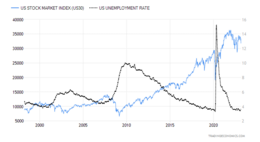March 20, 2023: Expected late market cycle chaosThe end of a stock market cycle is typically associated with market turmoil. A quick look back over the last 50 years will highlight these expected events. Inflation is often the catalyst for late market chaos. Since the 1970s, roaring inflationary pressures have been instrumental in causing most of the stock market peaks (Chart 1). At the end of the 1970 bull market, the US inflation rate soared up to 15%, and in response, the Fed raised the interest rate up to 20% to calm this destructive inflation trend. This action created an inverted yield curve. The results of this feat pushed the economy into a 2+ year recession, crashed the price of commodities, and drove the housing market into a multi-year slump. Unemployment topped out at 11%. The highest level since the 1930s. During the run-up to the 2000 stock market peak, technology stocks, many with no earnings, were on fire as prices leaped higher nearly every day. Inflationary pressures were still contained with a late market cycle movement to 4%. The US Unemployment Rate was also at 4%. The Fed Funds Rate popped up to about 7% in an attempt to cool off inflation. This action creating an inverted yield again. The next market cycle top came in 2008. This time it was caused by the financial crisis. House values were in freefall as mortgages were being defaulted, and major brokerage houses were filing for bankruptcy. The rise in interest rates crested at over 5%, the inflation rate spiked to 6%, and unemployment started to advance, hitting 10% by late 2009. The yield curve inverted in late 2006. Since the financial chaos of 2008 and 2009, the next 12 years, market and economic events have been calm. The S&P 500 has advanced over 235%, the US unemployment reached a 50-year low of 3.4%, and inflation remained contained at around 2%. Inflation has been the element that has upset this current bull market. Starting at about 2% in early 2021, this economic gauge recently topped out at 9.1%, the highest level in 40 years. US interest rates have taken flight and gone from 0.25% in 2022 to the present 4.75% in under 12 months. The US yield curve inverted in late 2022 (Chart 2). These late market cycle events of inflation, interest rate hikes, and inverted yield curves typically develop into market corrections. The rise in unemployment happens when the stock market starts to decline (Chart 3). Bottom line: We expect inflation to continually lessen into mid-year with interest rates following. The events over the past year have not yet affected corporate earnings. Data suggests that earnings will begin to decline in Q2/Q3 which will bring the corporation to lay off more employees, raising the unemployment rate. The negative impact of the inverted yield curve has not yet been felt. This is expected in Q2 or Q3. |

|
|
|
|
D.W. Dony and Associates
4973 Old West Saanich Rd.
Victoria, BC
V9E 2B2
|
.jpg)
.jpg)
